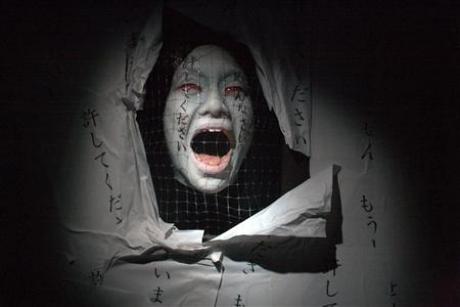 |
|
A ghost figure is pictured at a haunted house in Tokyo Dome City amusement park in Tokyo September 2, 2010.(Agencies) |
|
With Japan suffering its worst heatwave since records began in 1898, haunted houses or "obake yashiki" are doing a roaring trade as the traditional summertime venues to cool off. Ghost houses are set up especially for the summer in amusements parks in Japan with the tradition linked to Japanese Buddhism which views August as the time when ancestral spirits may return for a visit and Japanese visit their elders' graves. This year ghost houses have reported dramatic increases in visitor numbers as they tap into the Japanese tradition of also telling scary stories to send shivers down people's spines and cool them down. With temperatures still running high, Tokyo Dome City Attractions has extended its ghost house opening by a month. "Japanese naturally connect summer with being scared and feeling cool thanks to that," said the Dome's spokesman Yoshinosuke Goto. "We have run the summer ghost house here for last 19 years straight, but this year has been special and we have had many more customers thanks to the hot weather." In the past six weeks over 40,000 students, couples and company workers have flocked to the ghost house. "It was frightening! We were so tense we broke out in a cold sweat," said Takuya Fujita and Mai Uchino, service company workers, clinging to each other after leaving the haunted house. "We came here because it's very hot and we wanted feel a chill!" Japan is facing its hottest summer since the records began, with temperatures reaching 38.3 Celsius (100.9 Fahrenheit), leading to a reported 132 deaths and more than 30,000 people taken to hospital with heatstroke. The Japanese Meteorological Agency said on Wednesday the average temperature between June and August was 1.64 degrees Celsius above average for the period. The office did not give the actual average temperature. (Read by Nelly Min. Nelly Min is a journalist at the China Daily Web site.) (Agencies) |
日本今夏遭遇自1898年有氣象記錄以來的最熱酷暑,但傳統(tǒng)避暑勝地受到游客冷落,“鬼屋”生意卻異常火爆。 日本的“鬼屋”專門開設(shè)在夏季的游樂場所里,這與日本的佛教傳統(tǒng)有關(guān)。按照當(dāng)?shù)亓?xí)俗,祖先神靈可能會在8月返家,日本人也要在8月為先人掃墓。 據(jù)報道,今年“鬼屋”游客數(shù)量猛增是由于“鬼屋”還利用了日本的另一習(xí)俗:給人們講鬼故事,讓大家不寒而栗,從而“冷”下來。 由于氣溫居高不下,東京后樂園游樂場將“鬼屋”的開放時間延長了一個月。 游樂園發(fā)言人五斗義之助說:“由于有了‘鬼屋’,日本人很自然地就把夏天和嚇得渾身冒冷汗聯(lián)系起來了。” “我們在過去19年的夏天一直在這里開‘鬼屋’,但今年很特殊,由于酷熱難耐,來這里的游客暴增。” 在過去6周里,超過4萬名學(xué)生、情侶、公司職員蜂擁至‘鬼屋’消暑。 服務(wù)行業(yè)職員藤田拓哉和內(nèi)野萬井在離開‘鬼屋’后緊緊地抱在了一起,說“太嚇人了!我們太緊張了,渾身冒冷汗。” “我們來這里是因為天氣太熱了,想涼快涼快。” 日本正遭遇有氣象記錄以來最熱的夏天,氣溫高達(dá)38.3攝氏度(100.9華氏度)。據(jù)報道已有132人因此喪生,3萬多人因中暑入院治療。 日本氣象廳于本周三表示,今年6月至8月間的平均氣溫比往常高出1.64攝氏度,但并未公布具體數(shù)據(jù)。 相關(guān)閱讀 (中國日報網(wǎng)英語點津 Julie 編輯馮明惠) |
|
Vocabulary: tap into: 發(fā)掘,利用 break out in a cold sweat: 突然全身冒冷汗 |
